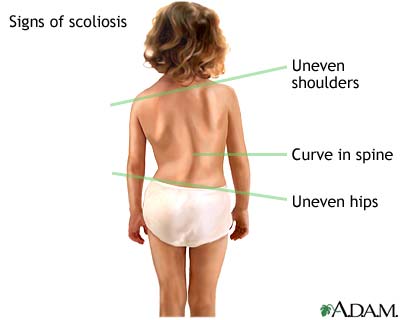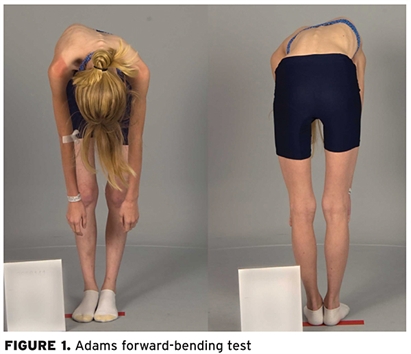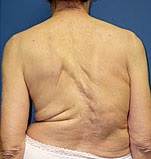Scoliosis Symptoms

What are the symptoms of scoliosis?
Scoliosis symptoms are often first noticed by a friend or family member because the changes in the spine happen gradually. They may notice your posture as suddenly changed or your back looks very different. Scoliosis is an abnormal twisting of the spine, but these curvatures always begin small, therefore the scoliosis may go completely unnoticed until the curve becomes quite large. As the curvature becomes more severe, you may begin to notice that your clothes no longer fit properly or a pant leg may seem shorter on one side.
[youtube=//youtu.be/fHWxsnh8o0Q&rel=0]
The most common signs of scoliosis are:
- An uneven waist
- A shoulder blade that sticks out
- Leaning to one side
A healthy spine when viewed from the side has a natural curvature, however, when viewed from behind the normal spine should appear as a straight line. An individual with scoliosis will appear to have a side-to-side twist in their spine.
Additional Scoliosis Signs & Symptoms
Scoliosis may also cause:
- The head to appear off center
- A higher hip
- A higher shoulder
- An visible curve in the back/spine
- Part of the rib cage to stick out
If the scoliosis is very severe, it can make it difficult for the heart and lungs to work properly. This can cause shortness of breath and chest pain.
Scoliosis Symptoms in Children & Teens
Often in children and teenagers, scoliosis does not have any noticeable symptoms. The curvature of the spine typically does not cause pain, and if it is mild, it can go undiagnosed. A larger curve can sometimes be found on a routine school screening exam for scoliosis. One of the most common tests for detecting scoliosis is called the Adam’s Forward Bend Test, in which the individual bends from the waist as if touching the toes. As you can see in the image below, one of the tell tale signs of scoliosis is a rib hump that can appear during this test.
Above all, the best way to measure scoliosis accurately is with an X-ray. Without an x-ray of the spine, there are several common physical signs that may indicate scoliosis.
Scoliosis Pain Symptoms
In adolescents, scoliosis can rarely cause back pain. When back pain is present with scoliosis, it may be because the curve in the spine is causing stress and pressure on the spinal discs, nerves, muscles, ligaments, or facet joints. If you or your child has pain associated with scoliosis, it is very important that they see a doctor specializing in scoliosis to find out what is causing the pain.
Read more about Scoliosis Pain >
Scoliosis Symptoms in Adults
In adult cases, scoliosis can often cause back pain and nerve root pain (pain caused by pinched nerves in the spine that radiates to other areas of the body such as the legs and arms). Other symptoms of adult scoliosis include:
- Hump on back upon bending
- Bump on spine
- Loss of height
- Shoulders and/or hips are uneven
- Pain, numbness, and/or weakness in the legs
- Difficulty walking
- Difficulty standing straight
- Feeling tired
- Feeling short of breath.Noticeable curve in spine from behind
Read more about Scoliosis in Adults >
Family History of Scoliosis
Scoliosis tends to run in families. The chances of developing scoliosis are greater in individuals who have a family member with the condition. A child who has a parent, brother, or sister with scoliosis should be regularly screened.
Read more about Scoliosis and Genetics >
Review the Symptoms and Signs of Scoliosis:
- Shoulders may not be of the same height (one is higher than the other)
- Head is not centered directly above the pelvis
- Rib Cage is not symmetrical; ribs may be at different heights
- A shoulder blade is higher and more prominent (sticks out more) than the other
- One hip is more prominent or higher than the other
- The individual may lean to one side
- One leg may appear shorter than the other
- The waist appears uneven
- Clothes do not fit/hang properly

When to see a doctor
If you suspect that you or your child have scoliosis or have noticed any of these signs, it is important to have an exam conducted by a scoliosis professional for proper diagnosis and possible treatment options.
Read more about Scoliosis Treatments >
To make an appointment or discuss your case, please call us at +1 (845) 624-0010 or contact us here.

